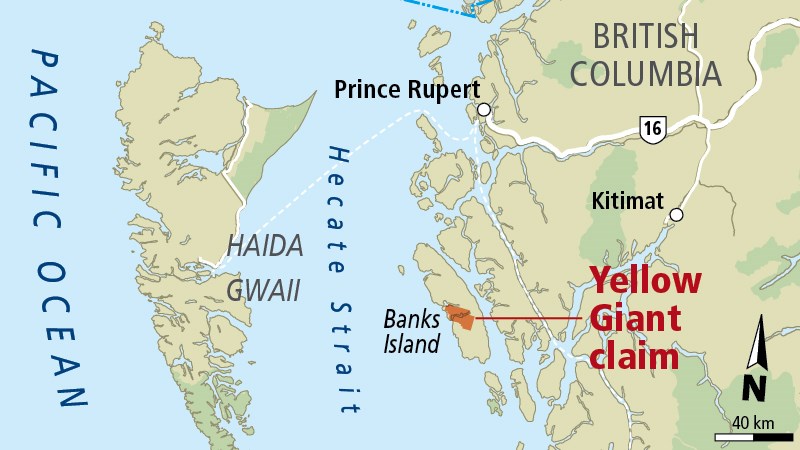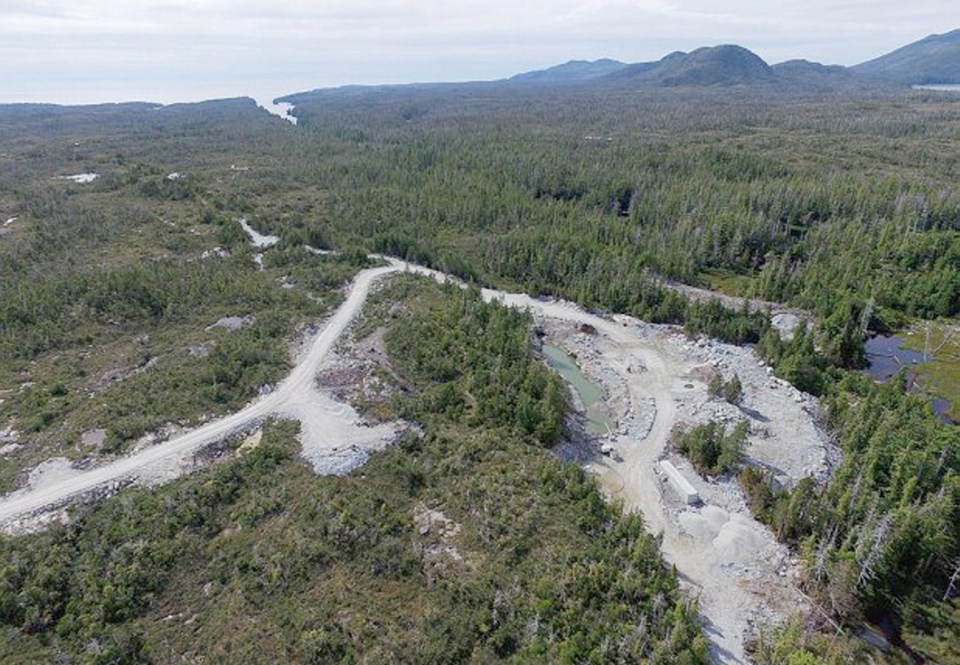The province has shut down the small Yellow Giant underground gold mine on Banks Island in northwest B.C. for spilling pollution on land and into creeks, lakes, and a wetland.
The B.C. environment ministry said the discharge reached the ocean through a creek, several beaver-dam-created wetlands and Banks Lake before entering the ocean at Surrey Bay, but it is not believed it will harm humans or animals.
The Yellow Giant incident is the latest of several mine waste spills — although much smaller in magnitude — since the catastrophic dam failure at Imperial Metals’ Mount Polley gold and copper mine in August 2014. There have been small spills at the Myra Falls and Copper Mountain mines in the past year.
First Nations and conservationists are concerned about the effect of this latest spill on animals and aquatic life, including salmon, at the island located about 100 kilometres south of Prince Rupert.
Pacific Wild executive director Ian McAllister, who lives in the area, visited the island on Sunday to get a first-hand look. Although he was blocked from the mine site by company personnel, a drone flight he carried out showed migrating salmon splashing in Banks Creek on their way to Banks Lake. There were also salmon jumping in the ocean at the mouth of the river, six to nine metres wide, he said, noting the area is rich in biodiversity, home to herring, a unique population of sandhill cranes and genetically distinct wolves.
“Whatever discharged into the system has gone into what appears to be a very productive salmon river,” McAllister said in a phone interview.
Gitxaala First Nation chief Clarence Innis said they will be launching legal action against Banks Island Gold and the province to ensure environmental damage caused by the spill is cleaned up.

The area is an important salmon area for the Gitxaala, as well as for other foods such as seaweed gathering, he said. “B.C. has to stop letting this industry essentially self-regulate themselves and start holding them accountable,” Innis said Sunday, adding they plan to carry out their own assessment of the spill.
Toxicity testing by a third-party laboratory on undiluted tailings effluent showed 100 per cent survival for rainbow trout and Daphnia magna (sometimes called a water flea), according to the environment ministry.
“Based on the toxicity test results, the distance to the ocean, the tendency for suspended sediments to settle out in wetlands, and dilution capacity of Surrey Bay, there is no reason to believe that there would be any risk to humans or animals,” ministry spokesman David Karn said in a written statement.
The environment ministry has ordered the company to clean up the spill, monitor its effects and come up with a long-term plan to ensure it does not happen again.
The Yellow Giant mine, owned by Vancouver-based Banks Island Gold, went into commercial production in January.
On July 15, the Ministry of Energy of Mines issued a shutdown order to the mine that did not become public until late last week.
“(The mine) is shut down until an updated water management plan (including all water sources from exploration sites), tailings management plan, and erosion and sediment control plans are provided and accepted by the chief inspector of mines,” mines spokesman Dan Gilmore said in a written statement Sunday.
That shutdown order followed a July 10 order from the environment ministry for Yellow Giant to stop releasing pollution into the environment.
The province said the company had “unauthorized” discharges of effluent in March and also effluent and tailings discharges in June and again in July. Tailings are the finely ground rock remaining after processing that contain potentially toxic metals.
Effluent and mine waste leaked from a pair of underground mine sites, including from a “non-engineered” containment berm and a concrete plug at an old underground site, according to the environment ministry’s July 10 pollution abatement order.
At one site, estimates from the company peg the spilled water containing tailings slurry at 240 cubic metres. That is much smaller than the 24 million cubic metres of water and tailings that was released in the Mount Polley spill. There is no estimate for the spill at the second Yellow Giant site.
The ministry of environment says the tailings spill has raised levels of suspended solids in the water, with a corresponding increase of concentrations of various metals, including arsenic, chromium, copper, lead, manganese, and zinc.
The discharge occurred approximately one kilometre from the ocean.
Banks Island Gold company officials could not be reached for comment on Sunday.
In a news release released last Friday, the company said it is in ongoing discussions with provincial officials and will continue limited activities on-site in the next few days as it works with the regulatory authorities to ensure that operations can continue uninterrupted on a go-forward basis.



